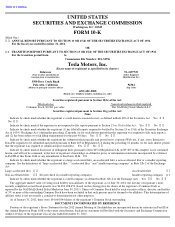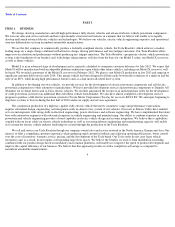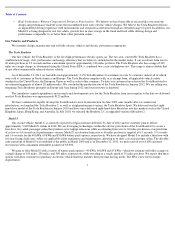Tesla 2012 Annual Report Download - page 9
Download and view the complete annual report
Please find page 9 of the 2012 Tesla annual report below. You can navigate through the pages in the report by either clicking on the pages listed below, or by using the keyword search tool below to find specific information within the annual report.
Table of Contents
will require us to label Model S utilizing new and different energy efficiency testing methodologies. These methodologies differ from the one we
have used to estimate the range of the vehicles at a steady speed of 55 miles per hour and could reduce the range reported on the required
labeling of our vehicles by up to 30% as compared to our current estimates.
To complement its range capabilities, we also are offering Model S with a package of recharging options. We are offering the capability to
fast charge Model S vehicles equipped with either the 60 kWh or 85 kWh battery packs at one of Tesla’s SuperCharger facilities, which we plan
to start installing at selected locations in the United States in 2012. We anticipate that the fast charge capability will allow Model S owners to
replenish 50% of the battery pack in about 30 minutes. This feature would offer these drivers a rapid and convenient way to recharge their
vehicles. In addition, we are designing Model S to incorporate a modular battery pack in the floor of the vehicle, enabling it to be rapidly
swapped out at a specialized commercial battery exchange facility that we anticipate may be available in the future.
We are designing Model S to offer a compelling combination of functionality, convenience and styling without compromising performance
and energy efficiency. With the battery pack in the floor of the vehicle and the motor and gearbox in line with the rear axle, we have designed
Model S to provide best in class storage space of 36.8 cubic feet, including storage under both the tailgate and the hood. By way of comparison,
this storage space exceeds the approximately 14 cubic feet of storage available in the 2009 BMW 5 Series sedan and the approximately 21 cubic
feet of storage available in the 2009 Lincoln Town Car. We are also planning to equip Model S with premium luxury features, including a 17
inch touch screen driver interface, advanced wireless connectivity, such as 3G connectivity, and driver customization of the infotainment and
climate control systems of the vehicle. We are designing Model S with the intent to achieve a five star safety rating. We believe the intended
combination of performance, styling, convenience and energy efficiency of Model S will help position it as a compelling alternative to other
vehicles in the luxury and performance segments.
We have announced that the 45 kWh, 60 kWh and 85 kWh battery pack options of Model S will have an effective base price of $49,900,
$59,900, and $69,900, respectively, in the United States, assuming and after giving effect to the continuation of a United States federal tax credit
of $7,500 for the purchase of alternative fuel vehicles. Even without the tax credit, we believe the base list price will be competitive with other
premium vehicles. We have also announced a performance version of Model S. Equipped with the 85 kWh battery pack and a high performance
drive inverter, we anticipate that the Model S performance version will accelerate from zero to 60 miles per hour in 4.4 seconds. The effective
base price of the Model S performance version is $84,900.
We anticipate that the initial units of Model S will be introduced with a Signature Series which will have an 85 kWh battery pack and
include certain colors and interior options, some of which may not be available in the general production of Model S. We also offer the Signature
Series with a performance version. The effective base price of the Signature Series is $87,900 and the effective base price of the Signature Series
performance version is $97,900.
We are designing Model S to provide a lower cost of ownership as compared to other vehicles in its class. We consider the purchase price,
cost of fuel and the cost of maintenance over a six year ownership period in this calculation. We assume comparable residual values, warranties,
insurance costs and promotions and assume that currently available consumer incentives are still available at the time of a Model S purchase. In
addition to the competitive pricing of Model S relative to other premium vehicles, we estimate that customers of electric vehicles will enjoy
lower fuel costs. For example, assuming an average of 12,000 miles driven per year, an average electricity cost of 11.0 cents per kilowatt-hour
and an average gasoline price of $3.38 per gallon over the full ownership of the vehicle which were the average electricity cost and gasoline
price in the United States, respectively, for January 2012, and based on our estimate of the energy efficiency of Model S, we estimate that our
Model S could have approximately $1,900 per year less in fuel costs than a comparable premium internal combustion engine sedan.
Furthermore, we expect Model S will have lower maintenance costs than comparable premium internal combustion engine sedans due to fewer
moving parts and the absence of certain components, including oil, oil filters, spark plugs and engine valves.
8






















